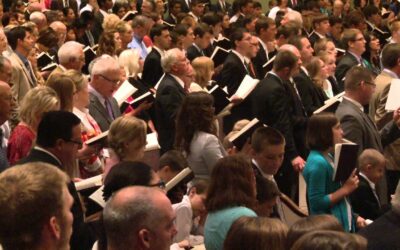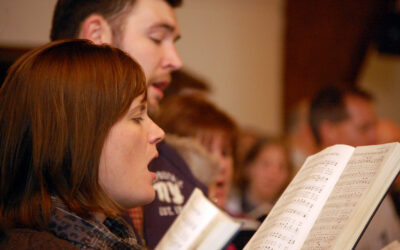Throughout the Bible we are instructed to be faithful stewards of all that God has given to us. We’re taught to bring our tithes and offerings to God in worship. The Psalms prescribe this responsibility. Jesus, in His earthly ministry, took an opportunity to have a teaching moment when wealthy Jews came to the temple to give their offerings that seemed generous but were only a fraction of their wealth. He contrasted their seeming extravagance with a poor widow who actually gave sacrificially. With this stark contrast Jesus taught his disciples what giving is all about.
In the New Testament the apostle Paul gives us examples of how we should be faithful stewards of our gifts. In his second epistle to the church in Corinth he tells about the church in Macedonia and how they are financially poor but rich in generosity. The church in Macedonia was so eager to give that they wanted to give more but Paul wouldn’t take it. But they gave joyfully and gratefully to further the work of spreading the Gospel. Paul then describes to the church in Corinth that they, a wealthy church, should give as generously as the church in Macedonia, a poor church. Paul reminds them of their wealth and what God has entrusted to them and asks them to give with the same enthusiastic generosity of the Macedonian church.
There are many other passages throughout the epistles where we are instructed to give generously. In 1stTimothy 6:17-19, Paul talks about being generous and to share with those that don’t have. In 2nd Corinthians 9:10-11 Paul talks about the good seed God gives us and that we are to be faithful with that seed, to plant that seed, and then to reap the bountiful harvest that comes from that seed, and then to give joyfully and praise God for the Harvest.
As a child I often heard about the illustrations that my parent’s beloved former pastor, Conrad R. Willard, would use in his sermons. Even though I was a generation away from their original hearing, they so moved my parents that they became apart of their teaching of my sister and me. One of the these illustrations was so important to me in my understanding of Christian stewardship. In the illustration, Dr. Willard told of an experience he had around Christmas time. He was in downtown Kansas City standing in front of Macy’s department store on Main street looking straight down Petticoat Lane, the fashionable center of retail at that time. And beside him was a Salvation Army bucket on a stand and on top of the stand was a sign. That sign had two sides. On the side facing Dr. Willard it simply read “The Salvation Army.” Soon three younger but clearly not very affluent ladies walk up to the bucket. Now, this was back in the late 1950s and at that point if you went downtown to shop you would have dressed nicely. Ladies would have been wearing hats and gloves and really dressed to the nines. But these ladies were not dressed as well as most of the other shoppers. Their clothing was very much out of style, a little faded and, perhaps ,slightly tattered. Their clothing wasn’t the best quality to begin with and it certainly hadn’t aged very well. As they approached the Salvation Army bucket a couple of them pointed to the sign, the side of the sign facing away from Dr. Willard. He could not see the sign, the side of the sign they were pointing to. As they pointed to the sign they began talking amongst themselves, opened their purses, dug around, and pulling out a few coins. They dropped the coins into the bucket and then walked off. Dr. Willard thought this was a little unusual since these ladies (who were donating to the Salvation Army) looked like the type of people that would have been receiving the services that the Salvation Army offered. He was curious to know what the other side of the sign said. So he walked around the bucked and look up at the sign. It said “this year give to someone in need.”
As a child this illustration struck me and taught me that our perception of need and ability sometimes gets skewed. Jesus took a seemingly ordinary moment to teach His disciples about an extraordinary demonstration of faith. Both of these are sacred, holy moments where we see portrayed God’s faithfulness to us and our acting on that faithfulness in trust by giving.
In the offertory we are contributing as an act of worship. By doing so we demonstrate that we know what we have comes from God “from whom all blessings flow.” We recognize that we are stewards of these gifts. They’re given to us. They aren’t ours. But we have been given them to use to serve and honor God. God gives these gifts to us and it is a sacred trust. By giving in worship we testify to God’s faithfulness to us, and we testify of our trust and faith in Him to provide for all our needs. Giving in the offertory is an act of worship. In corporate worship we need to make sure that we treat the offertory as a high moment, a high act of worship. Yes, collecting the offering has a practical function. But it’s not just a practical act. It is an act of worship.
The best practices in traditional worship will treat the offertory as an honored and respected act of worship not a nasty necessity or simply something we do. Giving during the offertory is an act we do out of our love for God and our belief that He will provide for our needs. We need to make sure that we treat it as a sacred, holy moment, not just something we do during worship.
There are four parts of the offering in worship. The first is the call to the offering where we simply remind the congregation that all we have comes from God and we bring a portion of that back to Him to do His work in His world. The second is the collection of the offering—passing the plate. The third is the presentation of those gifts, combined together in full view of the entire congregation. And the fourth part is the prayer of dedication where we thank God for the gifts that He has given us, for the lives of those who gave the offerings, for the faith they proclaim by giving their gift, and corporately, together, lift them up and dedicate them to do the work God has called us to do.
As a seminary student I attended a church that understood the importance of the offertory in worship. Upon the arrival of a new pastor he requested the church make a change in the way it presented the offerings to God. He asked that after the offering was collected the ushers assemble in the back of the church until the offertory music ended. He then asked the ushers to walk with the offering plates down the aisle of the church toward the front. As the ushers passed each row of pews the pastor asked that the congregation stand. So as the ushers moved toward the front of the church each successive row stood in sequence. It was phenomenal to watch but it was a spine-tingling moment when I realized that it was a physical representation the Body of Christ presenting themselves and their offerings to God. It was an amazing way to engage the congregation in the presentation as an active act of worship. And, of course, once the presentation concluded the congregation sang an appropriate short hymn of praise. Historically the Doxology has been the perfect hymn to sing at the presentation of the offering—”Praise God from whom all blessings flow, Praise Him, all creatures here below; Praise Him above, ye heav’nly hosts; Praise Father, Son and Holy Ghost”—for it acknowledges that God is the source of all our blessings and exhorts all to praise Him.
Given the importance of the act of giving as a part of worship, a congregation should avoid anything that minimizes the importance of the offertory. The offertory is not a time for announcements or other housekeeping tasks. The offertory is not expendable but rather is a crucial part of weekly worship. The offertory should be a time of focused worship where the congregation is taught and practices a discipline of giving. And certainly the offertory should not be relegated to the instruction “drop your offering off with the ushers as you walk out the door.” This unwise treatment of the offertory teaches bad theology rather than teaching that the offertory is a significant act of worship. Avoid anything that minimize this act of worship. Instead focus the congregation on the act. Teach them why the offertory is important.
It is perfectly appropriate to have musicians (solo instrumentalists, solo vocalists, or ensembles) present a musical offering during the collection. These “offertory solos” give the musicians in a congregation the opportunity to share the gift God has given them and, more importantly, to offer their music to God as an act of worship. Offertory music can enhance the collection of the offering and help the congregation to focus on THEIR giving while they listen to musicians give their gift to God. Make sure that offertory musicians understand that they are not performing for the congregation but rather they are giving their musical gift to God as an act of worship. Their music is their personal worship to God displayed corporately for the body to see and enrich their act of worship by giving. Teaching the reason for the offertory, to both the musicians and congregation, will lead all to a full and sound understanding of the offertory as an act of worship.
__________
Sacred Song Consulting exists solely to help congregations refine, revitalize, and reform traditional worship for contemporary people. We are a resource for all worship leaders. We are a guide to lead you to the best practices of traditional worship. We provide you with the tools to plan, prepare, and lead traditional worship, the nuts-and-bolts concepts that help traditional worship honor God and enrich the congregation. We are here to help you! You are not alone in your desire to have transformative worship in your congregation. Reach out to us. Let us know how we can help you!



0 Comments